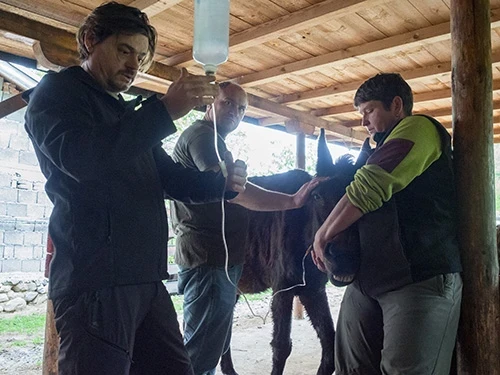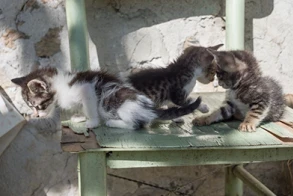MARIA’S INJURY
Maria is the only mule in the valley. Even though the old etiquette insists that a lady’s age should never be revealed, we move with the times and don’t mind sharing that Maria is a 30-year-old lady who looks pretty good.
Since we’ve said how old she is, she wouldn’t care if we mentioned her weight, too: Maria hits the scales at around 300 kilos (or 660 pounds). She has been a resident of our sanctuary for three years. It’s all about the number three with our special lady but in this story, we hope to stick to just one.
Maria spent long years carrying loads up and down the mountain. Our project was designed for donkeys but we could not turn her down. After talking to her owners, it was obvious they were caring and very concerned for her future, for which they could no longer provide. So we decided to give her shelter.

Maria’s problem was visible from the day she arrived – she had trouble with her front leg and was no longer able to do any work.

We did our best to neutralize the injury but over time Maria developed a pathology: she kept hurting the same spot again and again. She might not be a cantankerous mule but she is still quite temperamental and that has its consequences.
Her last injury is more serious than the rest so we settle her in the ‘infirmary’ – the stables where the oldest donkeys live so they could be under constant watch.
One morning we find her on the ground and she simply can’t get back up on her feet.

Four people and a sling manage to get Maria up. We must be very careful not just for potential injuries but we don’t want to add more distress to the animal’s plight.


We give her time to calm and feel stable and we carefully examine her front left leg.

We can’t leave her in the sling – if she lost her balance, she would put all her weight on the material and it isn’t designed to support it independently. So we take our time to make sure she is stable standing and moving and we compensate for the fourth leg as we lead her on the other three to the stables. She needs her foot and we need to examine her again and start thinking about treatment.


Before we are ready with our final diagnosis we give her an IV with painkillers and anti-inflammatory medication. Plus, another essential element in any animal therapy: lots of TLC.


Maria’s final diagnosis is a tearing in the joint capsule of the knee, leading to articular bleeding into the cavity. The condition is also known as hemarthrosis. Our vets drain the excess liquid that has gathered in the cavity to relieve the tension in the joint. They also apply topical medication. Lastly, they apply anti-inflammatory cream and make a tight bandage.

Maria is going to get painkillers and anti-inflammatory meds every day until there is marked improvement.

In a couple of days, Maria is let out for her first walk. She seems almost graceful as she makes her way to the nearby grass stretch where delicious fresh grass awaits her.
 After another few days and Maria starts using her foot but is still cautious when she doesn’t move. Her recovery is going according to plan and she will soon return to her main group. We sincerely hope it’s the last of her injuries and we will do our utmost best to help her heal fully.
After another few days and Maria starts using her foot but is still cautious when she doesn’t move. Her recovery is going according to plan and she will soon return to her main group. We sincerely hope it’s the last of her injuries and we will do our utmost best to help her heal fully.



